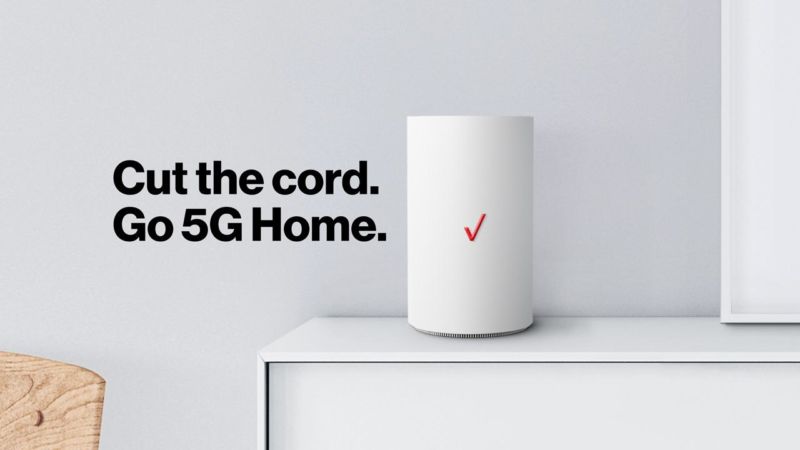
Verizon says it will bring its “5G Home” Internet service to every market where it deploys 5G mobile service.
That might not be saying much, given how limited Verizon’s early 5G deployments are. But it would mean that at least some people in each 5G mobile market would be able to buy the 5G fixed Internet service, which offers an alternative to wired Internet.
“You should expect that every market that opens a 5G mobility market will in due course be a 5G fixed wireless [market] because it is one network,” Verizon Consumer Group CEO Ronan Dunne said Wednesday at an investor conference (link to webcast and transcript).
Verizon brought 5G Home to parts of four cities—Houston, Indianapolis, Los Angeles, and Sacramento—late last year, charging $70 a month for service with no data caps and typical download speeds of 300Mbps.
Verizon plans to launch 5G mobile in parts of 30 cities by the end of 2019, and the company has done so in 10 of those cities so far. Those cities are Chicago, Denver, Minneapolis, St. Paul, Phoenix, Providence, Washington DC, Atlanta, Detroit, and Indianapolis. Other cities getting Verizon mobile 5G later this year include Boston, Charlotte, Cincinnati, Cleveland, Columbus, Dallas, Des Moines, Houston, Kansas City, Little Rock, Memphis, San Diego, and Salt Lake City.
After testing the home service in the four pilot cities, Dunne said Verizon is “ready to go mass market” with 5G Home. The “full commercial launch” of the home service will happen in the “back end of this year,” he said.
Early 5G deployments are limited
But Verizon’s early 5G launches, which use millimeter-wave spectrum for both mobile and home service, have been anything but widespread. This isn’t surprising, given that these high-band frequencies have trouble covering large distances and indoor spaces. Reviewers of early Verizon 5G mobile deployments had trouble finding mobile signals, and Verizon’s 5G Home service only covered a fraction of each launch city.
5G can work on any frequency, but the biggest speed gains come on millimeter-wave spectrum bands because there’s simply more spectrum available in those higher frequencies. But carriers have admitted that millimeter-wave coverage won’t scale beyond densely populated urban areas.
Verizon rolled out millimeter-wave 5G to 13 NFL stadiums, but the network isn’t good enough to cover all of the seating areas in any one of those stadiums. In some of those cities, the stadium is the only place where Verizon 5G is available at all.
Given that, you shouldn’t necessarily expect to get Verizon 5G home Internet even if you’re in one of the upcoming launch cities. But if your home is in range of the Verizon network, it could be a good option since it’s a fixed connection rather than a mobile one that can vary widely in speed and availability as you move about a city.
In-home antennas
Verizon’s first 5G Home launch was based on its own version of 5G instead of the 5G New Radio (NR) industry standard. But toward the end of this year, Dunne said that Verizon “will launch the first of our 5G Home markets that are on the NR platform.” That’s because NR equipment is now becoming readily available, Verizon said.
Despite using non-standard 5G, the early deployments in four cities helped Verizon “understand how we develop our go-to-market and how we actually market street-by-street,” Dunne also said. The early deployment helped Verizon determine the right “balance between indoor and outdoor antennas and the proportion of those indoor antennas that can be self-activated rather than needing to have a truck roll,” he said.
Nearly 80 percent of new 5G Home deployments rely on an antenna inside a customer’s home instead of outside, like on the roof, making it easier for customers to set it up themselves, he said. “That’s critical for [customers], the ability to self-provision,” he said. Like wired Internet, the fixed wireless service uses a router in the home to create a Wi-Fi network.
The in-home equipment today is “effectively using a cellphone chipset” instead of something more powerful, Dunne said. But the next generation of chips available in the first half of 2020 will bring “higher power output” to the home Internet service, he said.
Verizon will eventually deploy mobile 5G on the lower-band spectrum it uses for 4G, but Verizon says the speed gains from 5G on this spectrum will be minimal. If Verizon also brings 5G Home to lower spectrum bands, we’d expect that the top speeds would fall far short of what cable and fiber networks are capable of, and there’d be a greater likelihood of Verizon imposing data caps.
